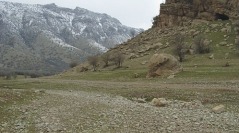

 Comptes Rendus Palevol
17 (6) - Pages 335-345
Comptes Rendus Palevol
17 (6) - Pages 335-345Along with the early age obtained for the cultural remains attributed to anatomically modern humans from Kaldar Cave, the archaeological assemblages recovered from both Kaldar and Gilvaran Cave located in the Khorramabad Valley (Iran), have yielded charcoal remains that allow the identification of Prunus spp. These remains correspond to the Middle and Upper Palaeolithic, which are the earliest finds attesting to the presence of this taxa in the area. Our anatomical observation of the samples revealed the presence of Prunus spp. (plums) and Prunus cf. amygdalus (cf. almond). This also reflects specific plant communities in the area, characteristic of open forest growing in cool, dry conditions. These results provide new insights into the arboreal cover in this area during an Upper Pleistocene period. Furthermore, anthracological evidence together with other contextual materials provides new clues to assess how Neanderthals and early modern humans adapted to their surrounding landscape, and their relationship with their environment in this region and beyond.
Anthracology, Iran, Prunus spp., Palaeoecology, Arboreal vegetation, Fuel